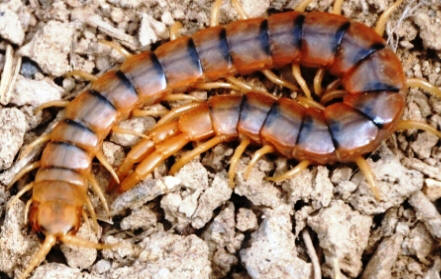
<>
Northwest Wildlife Online
by John M. Regan
Birds Mammals Reptiles Amphibians Fish Invertebrates Home
Mission Editor Bio Contact Wildlife Park Links Further Study Wild Employment Northwest Trek
CENTIPEDES 101
John M. Regan

Centipedes are a fascinating branch of the arthropod order of animals grouped under the Class Chilipoda – many footed - an apt description of this resident of the unseen world beneath our feet. The term Centipede, “100 feet,” is not, however, totally or accurately descriptive. Centipedes may have anywhere from ten to over a hundred “feet.”
But while the centipede’s name reflects its most immediately visible
characteristic there is a lot more to this creature.
“Centipredator” might have been a better name, because they most
certainly are predators, and masters at the game.
All those legs propel this invertebrate with great speed and under the
head is the business end of the animal, a pair of powerful fangs called
forcipules. Forcipules
differ from all other types of fangs in the reptile and arthropod world; they
not true mouthparts, they are modified legs, but so completely adapted to their
purpose that they even have venom glands running to the tips.
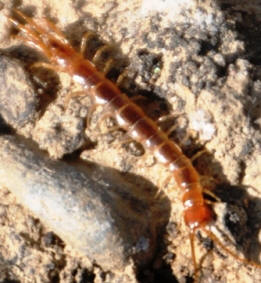
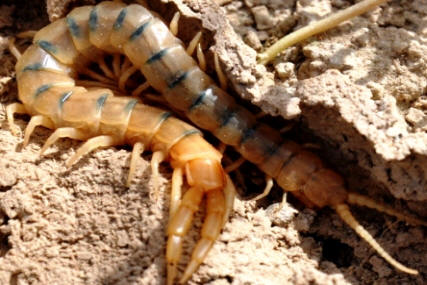

Just about everyone has seen a centipede or a millipede, recognized the
similarity, but correctly observed that the two animals were just not the same.
It is relatively easy to determine the difference: pick up a centipede
and it will probably bite you; millipedes won’t.
What’s that? You say you’d
rather not try that kind of a species test?
Well, okay, here’s another way to tell.
In general centipedes have one leg per body segment; millipedes have two
legs per body segment. Millipedes,
despite having twice as many legs, move a lot slower and are not as moisture
dependent as their lesser legged cousins.
Millipedes are often seen strolling slowly about in the middle of the day
while centipedes remain hunkered down under rocks and logs.
An interesting fact about centipede legs is their relative length.
Apparently someone actually has measured them and found that the foremost
leg is slightly longer than the leg behind it, thus aiding coordination of all
those appendages.
Of course, I highly discourage picking up a centipede.
Those forcipules, in addition to being poisonous, are powerful.
A large centipede can deliver a painful puncture with or without venom.
There are, however, safe methods to pick one up.
A pair of medical forceps, for example, works extremely well.
But in case you are not a doctor or related to one there are
alternatives. Needle nosed pliers
do the job. For the nimble of
finger, even a pair of chop sticks will suffice.
(I have actually done this and it works.)
For the photos below, however, I used the pliers function on my Gerber
knife. Whatever you decide to use,
please be careful for yourself and the animal.
Centipedes are tough, but you can easily hurt them and I hate to see any
of my little friends suffer.


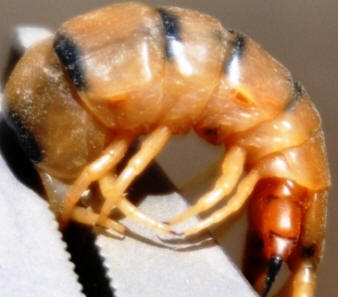
Why would you want to pick up centipede anyway?
Observation, of course. The
buggers are fast and trying to observe one is pretty difficult when all those
legs kick in to high gear.
Centipedes shun the limelight and the sunlight.
The first thing one will do when you find it under a log or rock is
scramble to safety. Safety to a
centipede is anything in can crawl into or under; either way it makes close
observation very difficult and you really can’t appreciate the anatomy of these
fascinating animals until you slow it down somehow.
Something you notice right away in examining your Chilipoda specimen are the
segmented body parts. These
segments grow at different rates throughout the creature’s life; the rate of
growth depends on the species.
Attached to each segment is a single pair of legs, one leg on each side as
opposed to millipedes which have two.
Each leg ends in a tiny claw.
The head is fairly flat and a pair of long, distinctly segmented antenna
protrudes from it. At the base of
the antenna you’ll notice a pair of small dark spots.
These are compound eyes, although most research indicates that centipedes
are only capable of sensing light from dark.
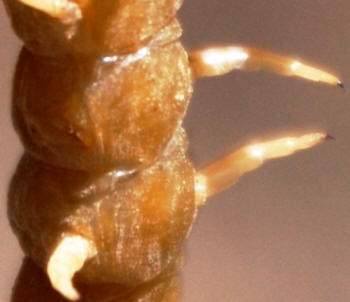


Directly under the centipede’s head are the powerful, fanged mandibles
called forcipules discussed previously.
Note the centipede’s tail. A
pair of bristled appendages juts out from the back end.
These appendages act as a kind of “rear view window” antenna. I’ve seen
these appendages wriggle in an odd twitching motion while the rest of the
animals had buried itself in the ground, almost as if they were radar searching
for a signal. This might also
serve as a defense mechanism designed to fool predators as to which end is
which.
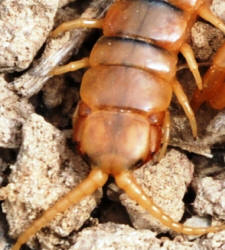
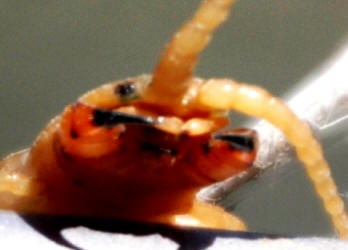
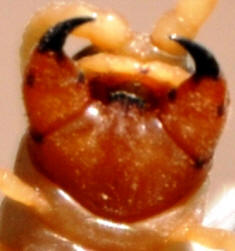
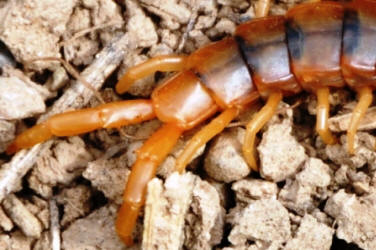
Although they have not achieved the notoriety of scorpions and camel
spiders, centipedes have inspired some fairly wild tales.
As previously discussed they are not deadly poisonous and they are not
out to hunt unsuspecting humans.
Although they do reach respectable lengths of up to twelve inches, that is about
the maximum. The largest is said to
be the Amazonian Giant Centipede, but the Texas Giant Centipede is claimed to
reach lengths in excess of one foot as well.
(But what else can you expect of a Texan centipede?)
I’ve also read claims of the Giant Peruvian Centipede reaching lengths
over twelve inches. There are even
one or two You Tube videos featuring a centipede attacking and eating a mouse.
As usual
in these cases overactive imaginations and storytelling prowess often prevails
over reality so beware of outrageous claims; it appears that one foot is about
maximum, but hey, that’s a big chilipoda!
They largest member of the class I have seen measured just about six
inches long. But even that is a big
centipede and is a bit startling when it appears unexpectedly.
What about the smallest? A
recent story in the New York Times (in the opinion column of all places) claims
the discovery of a 0.4 inch “Central Park Centipede”
Nannarrup hoffmani, more properly
called Hoffman’s Dwarf Centipede, is
the smallest in the world.
Certainly a little guy, but is it the smallest? I don’t know, there are a lot of
centipedes in the world and they aren’t all easy to find, but the Guinness Book
of World Records does indeed list this little centipede as the smallest.
In a relatively small patch of ground during my own observations I’ve
seen these guys range in size from that mentioned above (and maybe smaller) inch
to in excess of six inches. I have
seen five or six different species in an area no bigger than child’s swimming
pool. Gives you an idea of how many
there must be worldwide. The number
of centipedes worldwide must be staggering, but that’s to be expected in a lot
of invertebrates so I am always suspicious about definitive claims with these
guys in regard to numbers and size.
For now, however, let’s take the good Guinness people at their word.
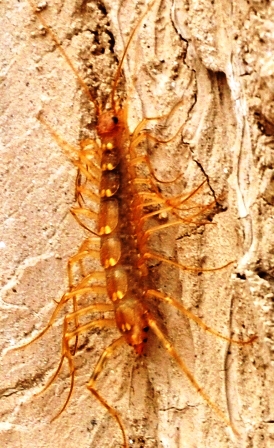


Most centipedes sport that long,
lean, dangerous look, but there is an exception to the rule.
The House Centipede, of which there are several species, has taken a new
tact with a much shorter body and much longer legs.
Apparently the common name comes from their fondness for human
habitations, I’ve always thought the name Hairy Centipede to be more descriptive
of these mop like centipedes.
Although I cannot claim to have ever seen one in my home, they must be a common
nuisance judging from the number of products and companies that claim methods to
get rid of them.
So there
you have it – your non credit Centipede 101 course.
But if you interested in furthering your chilipodian education I
recommend the following sources:
Oklahoma State University:
http://pods.dasnr.okstate.edu/docushare/dsweb/Get/Document-2295/EPP-7316web.pdf
Iowa State University:
http://www.ipm.iastate.edu/ipm/iiin/housece.html
Iowa State
The Pied Piper:
http://www.the-piedpiper.co.uk/th11d.htm
HOOAH
Jack
Birds Mammals Reptiles Amphibians Fish Invertebrates Home
Mission Editor Bio Contact Wildlife Park Links Further Study Wild Employment Northwest Trek
<>